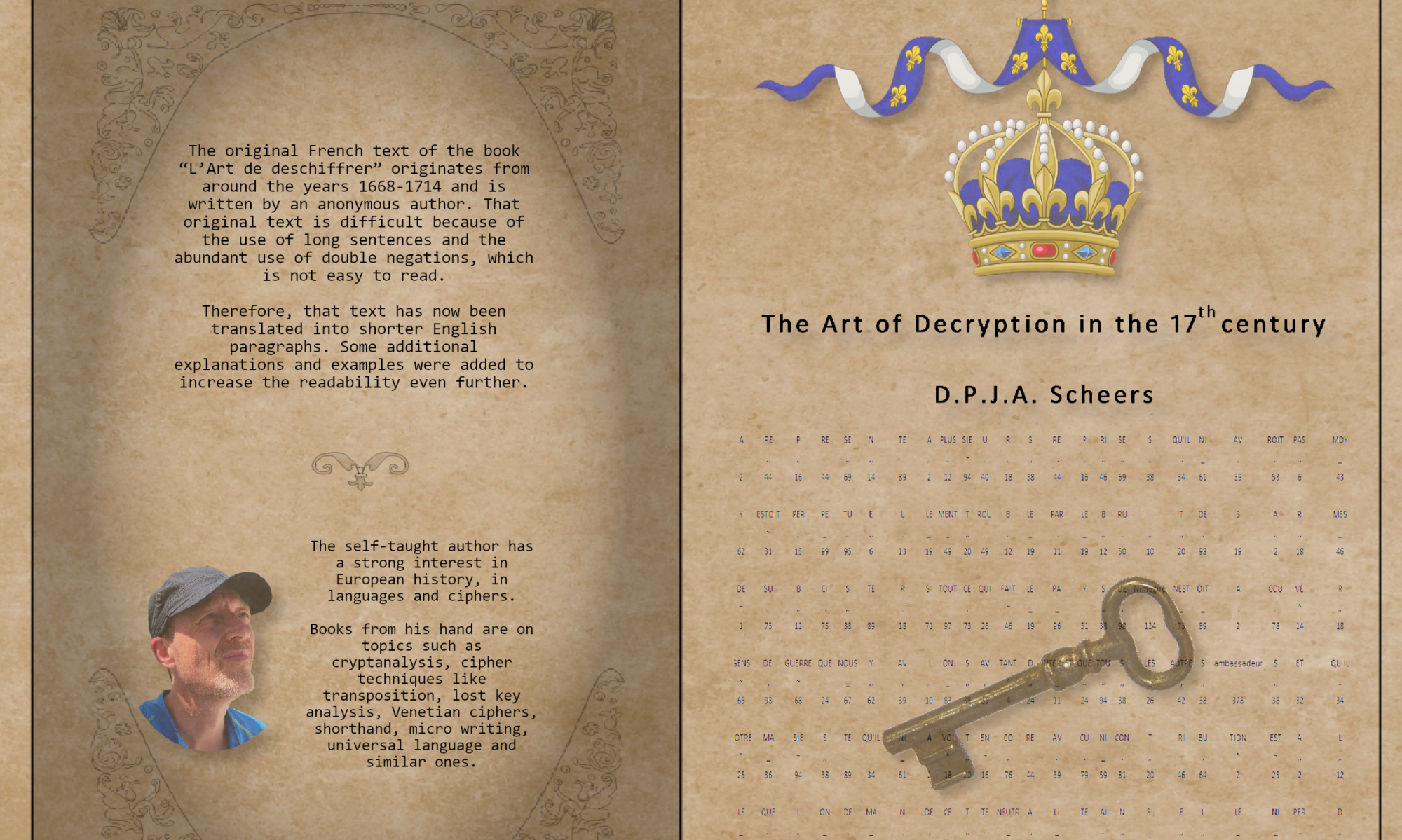Category: Nonfiction » Computers & Internet » Security / cryptography
Category: Nonfiction » History » European » Europe / France
Published: Oct. 1, 2019
Words: 35,800
Language: English

The Art of Decryption in the 17th century
Original French title: L’art de deschiffrer. Traité de déchiffrement du XVIIe siècle
de la Secrétairerie d’Etat et de Guerre Espagnole
Summary:
Translated from the original French handbook that describes the decryption of simple and composite French and Spanish ciphers in the 17th century and shows the applied methods and examples.
1668 – 1714. Published in French 1967 by J.P. Devos, H. Seligman. Université De Louvain.
Smashwords Edition.
Published by D.P.J.A. Scheers at Smashwords .ISBN: 9780463602256
Pages: +/- 125
Table of contents:
Preface by translator
Summary
Introduction
Manuscript form
Conservation state
Table of contents
Treatise on the art of decryption
Chapter I : General principles on the art of decryption
Chapter II: Specific principles on the art of decryption
Chapter III: Decryption method for simple cipher in Spanish and French
Chapter IV: Application of the axioms and the rules that have been defined
First problem
Second problem
Application of axioms
Chapter V: Composite ciphers
First observation on the composite ciphers
Second observation
Third observation
Fourth observation
Fifth observation
Sixth observation
Seventh observation
Eighth observation
Ninth observation
Tenth observation
Eleventh observation
Twelfth observation
Thirteenth observation
Fourteenth observation
Fifteenth observation
Sixteenth observation
Chapter VI: Specific principles that facilitate the art of decryption
First principle
Second principle
Third principle
Chapter VII: Application of the previous rules concerning the composite cipher
First problem
Decipherment of a Spanish composite cipher
Notes on the previous problem
Second problem
Reflections on the previous problem
Chapter VIII: Decryption method for certain particular ciphers
Chapter IX: decryption method for a special cipher
Chapter X: Indecipherable ciphers
Appendix to chapter VII, second problem, Nijmegen interception 1676
Appendix: Letter frequencies of English, French, Spanish, Dutch
Endnotes
- this is a preview-
Ninth observation
Sometimes a cipher character that is very seldomly used can prove to be useful during
decryption. It can give the conjecture of the meaning of some other characters, on where this character is attached, for example if it is near a character of which I suspect to know what it is, like a B. a G., or a X. These are rarely seen in a ciphered letter.
It gives me opportunity there to recognize others which are more significant, if it is a B.
then it’s necessary that the following syllable is one of the following five: “la. le. li. lo. lu.”
or one of these: “
ra. re. ri. ro. ru. ou sa. se. si. so. su.” or finally “ta. te. ti. to. tu.”. If it is a G. the
characters that follow will be “la. le. li. lo. lu . na. ne. ni. no. nu.” or “ra. re. ri. ro. ru.”.
If it is a X. then the following is “
“pe. pi. pu. po. pre.” or “pri. ta. ou te. tra. ou tre.” or “ce”. The character that which
precedes it, must ordinarily be an E.
From which may be inferred that everything in a ciphered letter may help us more or less in its own ciphering, since often the least used characters make us familiar with the most significant ones.
Sometimes a point that the encryptor has placed inattentively, shows use the end of a word or a line. A sharp accent that he placed on a character will signal to us, that it is a syllable, for example as in the last letter in these words: “nécessité, trompé, réparé”, etc.
This minor detail caused once that a letter from the Resident of France at Liège was easily deciphered, which on itself was very well encrypted. The discovery of an X. inside caused that another letter was deciphered from Marquis de Louvoy 57 written to Marshal Estrade 58 in such a way that a decipherer can’t ignore. He must observe everything, up to the slightest accent and punctuation, being very sure that the slightest trivial thing can start very considerable conjectures. (34vo)

-preview-
Second problem
A French cipher composed in June 1676, will be decrypted. The letter was intercepted in the Netherlands and taken from a French courier who was delivering the letter from the Christian King to his ambassadors in Nijmegen, whose original is in the hands of the author of the present work.

